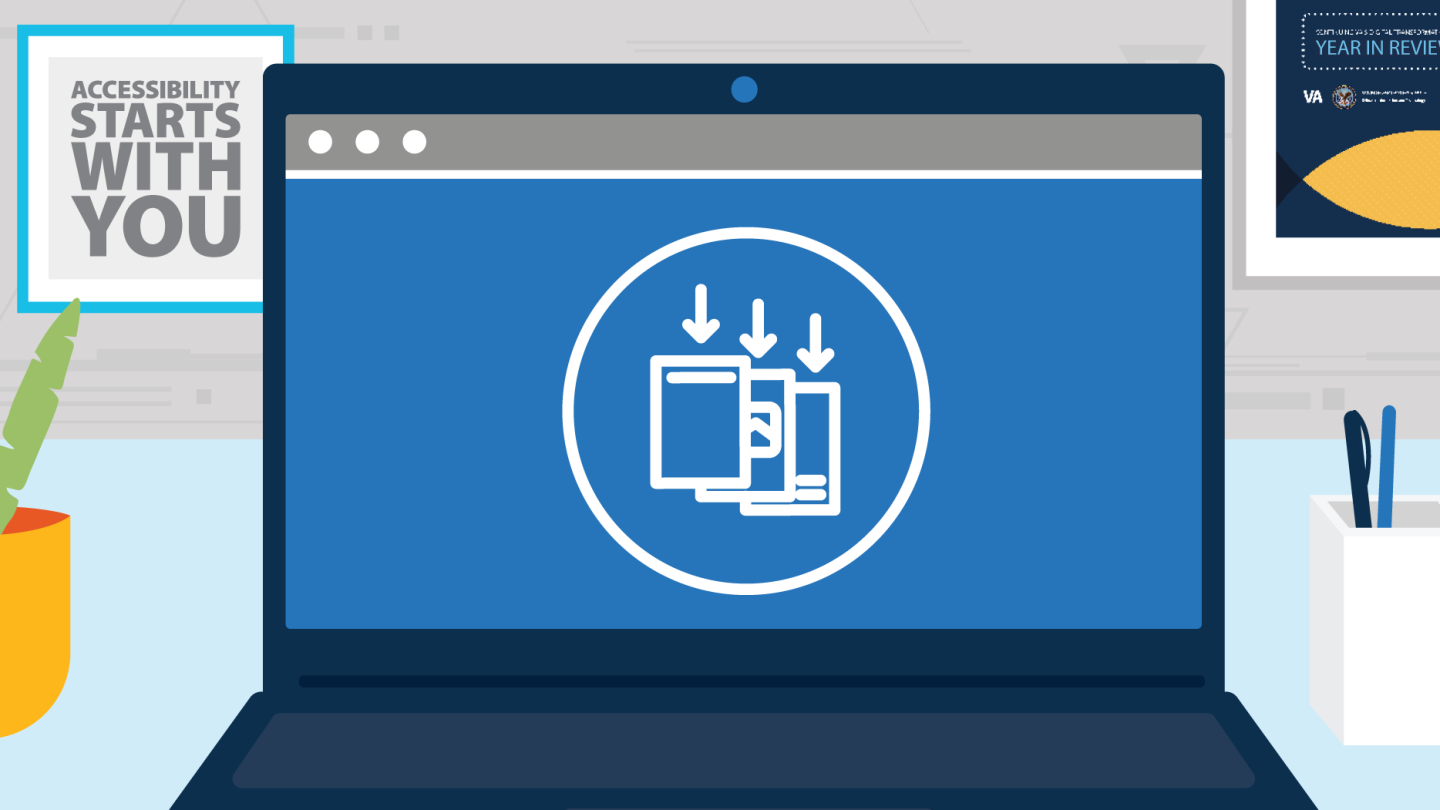Appears In
Picture a painting in an art gallery, an illustration in an article, or an advertisement on social media. Each of these images has meaning that is conveyed to the viewer however, many individuals affected by low vision or visual impairments lack the ability to see pictures, graphics, and other images, and may be deprived of the value these images add when included in an electronic platform, such as on a website or in an email.
Alt text, or “alternative” text, provides a way for such individuals to receive a description of the image in an audio versus visual format. The Department of Veterans Affairs (VA) Office of Information and Technology (OIT) understands that alt text is an essential component of designing accessibly to effectively convey important health information to Veterans, and those in their support networks, who are affected by low vision or are visually impaired.
Quality alt text speaks volumes
According to the World Health Organization, approximately 2.2 billion people are visually impaired. Of this demographic, an estimated one million Veterans are affected by compromised visibility. Such conditions are either the cause of low vision, the result of eye disorders such as glaucoma or cataracts, or due to colorblindness, which is the eye’s inability to perceive red, green, or blue light. These individuals may rely on screen readers that convert visual information into an audio format to navigate electronic platforms. Screen readers depend on a system of framework queues embedded in the document or platform’s structure to auditorily project the content in a logical sequence.
However, alt text is only as good as the accuracy of the image description. Section 508 of the Rehabilitation Act of 1973 requires all Federal agencies to ensure that any technological platforms used for official government purposes can be interpreted by anyone to the extent that it does not cause an “undue burden” for any specific group of people. OIT Accessibility goes a step further by educating the content creators — those individuals designing websites, sending emails, and creating PowerPoint presentations — about their role in integrating accessibility functions, including alt text, into their work products.
Martha Wilkes, Designer and Accessibility Strategist in OIT’s Office of the Chief Technology Officer, and Pat Sheehan, Chief of VA’s Section 508 Program Office, both understand how properly applied alt text makes content accessible to visually impaired individuals via a screen reader. They emphasize that using alt text, per Section 508 requirements, is only half the battle.
Many content creators confuse alt text with captions. For alt text to be effective, it must add descriptive value above and beyond a caption. For example, a website with a picture of a glass half full of milk might have a caption that reads “perspective is everything.” This may make sense in the larger context of the website, though a visually impaired person would still have no frame of reference for the image itself, regardless of the context in which it’s being used. Alt text should describe the image exactly as it appears, in a literal and meaningful way. In this example, alt text for the image should read “a glass exactly half full of milk,” instead of “a glass of milk,” or “a glass filled with milk.” Other alt text best practices include using phrases that are less than 250 characters, do not use abbreviations, and always ends with a period, which signals the screen reader to pause before continuing.
Alt text descriptions are not all created equally
Mr. Sheehan acknowledges that, when it comes to writing quality alt text, each description requires a unique approach, depending on the degree of detail included in the image and the value this adds to the overall message. For more detailed images, such as landscape pictures, it is best to focus on the overall impression of the image. Whatever scenery “is in the background [and] foreground is going to be a couple sentences,” he says. “In a landscape, is it a dark sky or a nice blue sky? What are the other colors that you see?” Similarly, alt text for a map requires knowing the overall effect the map is designed to convey. If it’s meant to be functional, an appropriate alt text description could include major landmarks, such as “a campground here, a forest over there, and hiking passes over here,” says Mr. Sheehan. Conversely, if the map orients the individual to a specific place and time in history, an alt text description might read “a map of Europe after World War II,” rather than describing specific topographical features. Alternatively, the alt text for an image of a portrait or headshot should include descriptive features, such as facial expressions or relevant physical characteristics. “Do you see a face that is happy and smiling or are you seeing belligerence,” Mr. Sheehan offers. The details should complement the information, such as if the face is meant to convey an emotion, serve as a symbol to personify a larger observation or message, or represent a specific group of people. The trick is to find the balance between detail and intent, Mr. Sheehan stresses.
Ms. Wilkes agrees that proper alt text is all about using images with intention by considering the reasoning behind each image choice. For example, when designing a website about a forest, “I may want to include pictures of trees for the readers.” What may appear to be an arbitrary choice to find a picture with trees, when considering an alt text description, becomes a deliberate selection of description factors, such as species, density, and geographical location. “Those are all different potential alt text descriptions, which makes you reinvestigate your design process and be intentional as to why a particular photo is displayed,” Ms. Wilkes says.
What about decorative elements? If a graphic is used for purely decorative purposes, such as calligraphy or other artistic embellishments, an alt text description is not required, however, the asset must be designated as decorative in the document structure for the screen reader to effectively interpret. A check box to designate an asset as artistic design is available as a part of the Accessibility Checker feature for all content created on Microsoft Office platforms such as Outlook, Word documents, or PowerPoint.
Ultimately, alt text promotes a human centered design approach by encouraging communication between content creators to be constantly expand their understanding of why they are using images and how to accurately describe them. Mr. Sheehan notes that “you’re getting synergy between different groups to work together to try to improve accessibility because [the design process has become more than] meeting the technical standards of accessibility, but [rather] being able to put it in usability or human centered design.”
Ms. Wilkes agrees that not choosing to design accessibly needs to be reframed as a deliberate decision, just as much as choosing to design accessibly is a decision. “Not paying attention to accessibility is a design choice,” she says. “You are at that moment choosing to exclude people who need this information and in its most basic properly formatted form…You are choosing to disable another person at that moment. It’s knowing that you have the power of that choice.” The takeaway is to ask yourself “why is this image important, what’s the image doing there, and what is it supposed to represent,” says Mr. Sheehan. Designing accessibly starts by making intentional choices as content creators, which is, in and of itself, an act of service to ensure that low vision and visually impaired Veterans, and those in their support network, have equitable access to the entirety of VA health and benefits information.
Accessibility starts with you. For more information on accessibility and incorporating alt text into your products, visit our getting started guide on alt text. To learn more about accessibility, explore OIT’s Accessibility Guide and watch OIT’s Accessibility videos.
Our commitment to digital and IT transformation is shaped by our daily dedication to customer service and the close collaboration of our workforce, managers, and leaders. Ready to join us in improving Veterans’ care? Check out all current information and technology career opportunities on DigitalVA. You can also contact VA’s Office of the Chief Human Capital Officer at 512-326-6600, Monday thru Friday, 7 a.m. to 5 p.m. CST or by submitting a resume to VACareers@va.gov.
Topics in this story
In this article
More stories
Link Disclaimer
This page includes links to other websites outside our control and jurisdiction. VA is not responsible for the privacy practices or the content of non-VA Web sites. We encourage you to review the privacy policy or terms and conditions of those sites to fully understand what information is collected and how it is used.
Statement of Endorsement
Reference herein to any specific commercial products, process, or service by trade name, trademark, manufacturer, or otherwise, does not necessarily constitute or imply its endorsement, recommendation, or favoring by the United States Government, and shall not be used for advertising or product endorsement purposes.








